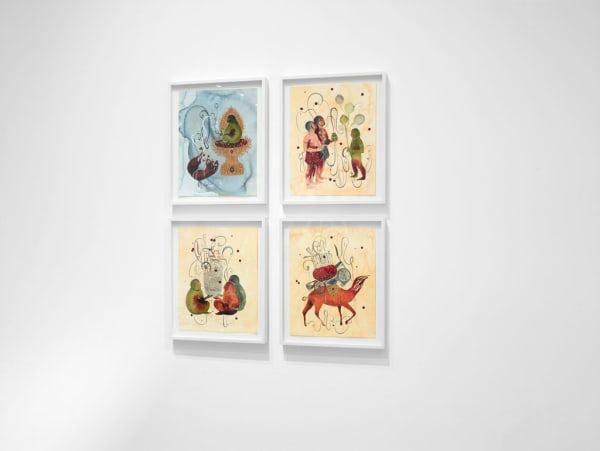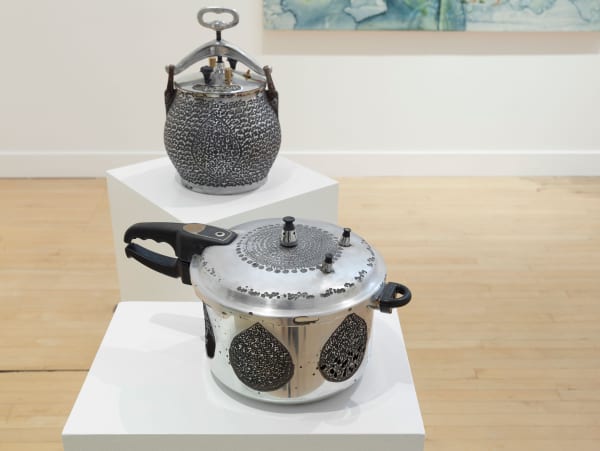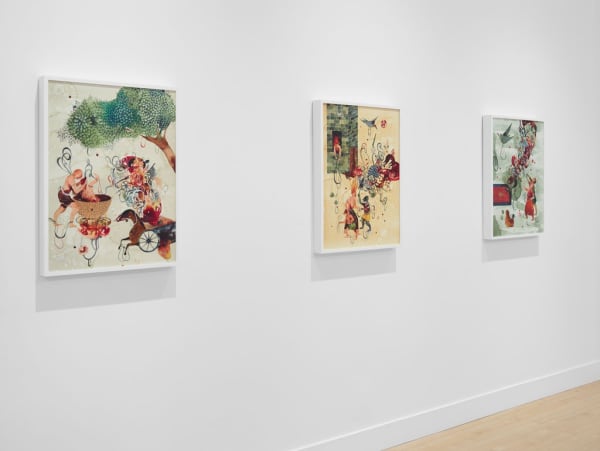Shiva Ahmadi: Burning Song
Haines Gallery is proud to present Burning Song, our first solo exhibition by Iranian American artist Shiva Ahmadi (b. 1975, Tehran, Iran; lives and works in the San Francisco Bay Area). Ahmadi draws from the artistic traditions of the Middle East to reflect on contemporary geopolitical tensions. Featuring a new body of work that is at once humorous, scathing, and heartbreaking, Burning Song is Ahmadi’s response to a world in turmoil.
Working across a variety of media that includes painting, digital animation, and sculpture, Ahmadi addresses the machinations of despotic regimes (and the complicity of their drone-like followers), the horrors of war, and their effects on innocent lives — using beauty to seduce the viewer into her exquisitely crafted scenes. The vibrant fantasy realms in Ahmadi’s works are, upon closer inspection, macabre theaters of conflict. The artist appropriates and subverts imagery derived from Persian and Indian miniature paintings, which traditionally depict courtly scenes, mythological epics, and the heroic feats of rulers. By contrast, in Ahmadi’s works, figures are faceless, bloodied, and enchained, linked together in endless cycles of violence. Headless horses drag chariots of fire and rubble. Overlaying washes of atmospheric watercolor with precisely applied inks and acrylic paint, Ahmadi conjures a world where fortified walls open to reveal not palaces, but oil refineries and nuclear power plants — allusions to modern seats of power.
Since 2015, Ahmadi has been concerned with the escalating refugee crisis in the Middle East and Europe and, more recently, the plight of detainees at the US-Mexico Border. Having come to the US from Iran in 1998, the immigrant experience is one that she is keenly aware of and sympathetic to. In a nod to the perpetual state of uncertainty that so many people are now experiencing, her new works see an growing tendency towards abstraction, with figures and scenes that are suggestive rather than descriptive. Tightly controlled tableaux are increasingly destabilized, with floating masses of rubble and viscera that suggest the aftermath of an explosion, the scattered pieces of what was once whole. Flying Carpet (2018), for example, depicts an ornate Persian rug, burning as onlookers point and pick. Such carpets are objects of cultural and historical significance in Iranian homes; throughout the exhibition, Ahmadi’s paintings speak to the anxiety of dislocation and the insecurities that arise when crossing into unfamiliar (and sometimes unwelcoming) lands.
The exhibition also includes Ahmadi’s latest animated video Ascend (2017), inspired in part by the now famous photograph of the Kurdish-Syrian toddler Alan Kurdi, who tragically drowned in the Mediterranean Sea as his family sought to escape the Syrian Civil War. In the seven-minute work, which was recently exhibited at the Asian Art Museum of San Francisco, an idyllic and tranquil scene of playful monkeys descends into darkness, with floating bubbles and balloons morphing into bombs — familiar motifs in Ahmadi’s work, akin to the candy-colored confetti that appears in several of her new paintings, which the artist describes as a device for “sugarcoating” ugly truths.
These works are exhibited in dialogue with new sculptures from Ahmadi’s Pressure Cooker series, first begun in 2016. These striking works have been meticulously decorated, every inch of their rounded surfaces hand-inscribed with delicate intaglio etchings. The works are created from Afghan pressure cookers, sourced from markets in Iran—a reference to real-world tools of violence, and more generally to the domesticity of terror. As with the rest of Ahmadi’s works in Burning Song, the potency of these sculptures lie in the tension between ornamentation and destruction.
















